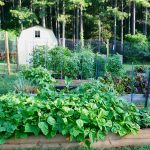 |
| Garden entrance – in warmer days! |
Gardening in January sounds like wishful thinking, but I found myself outside today in the flower garden for a good two hours today doing just that – gardening in January. Normally at the time of year in our Zone 6B garden the ground would be frozen solid, and it’s likely there would be a few inches to a foot or more of snow covering the ground. Not this year. This year, the crocus are already pushing up through the soil, as are the tulips. Even the tulips nearest the garage that are in a bed I consider “cool” because it doesn’t get direct sunlight until late afternoon are starting to break the soil. The forsythia look like they’ll bud at any moment, as do the peach trees. I’ve got yarrow blooming. Yarrow. And hollyhocks and foxglove with green, healthy leaves.

The weather patterns here in the Piedmon region are unpredictable. Some winters our garden is more like the gardens closer to the Blue Ridge Mountains – cold and snowy. Then periodically we get a winter like this, where I can be outdoors in my sweatshirt on January 28, trimming perennials back (that I should have done in the fall), fixing fallen peony and plant hoops, and pulling up some of the weedy grasses that sprinkle throughout the garden.
Doing the garden cleanup chores in January, when all of the perennials have died back, yielded several surprises. First, it was easier to see where my nemesis, the blackberry, had invaded the flower beds. I was actually cutting back the Rudbeckia and reached down to grab the dead canes when my thumb was stabbed with a sharp, shooting pain. Now you have to understand that my gardening gloves, which are less than a year old, are so worn that I have gigantic holes in the thumbs and a few fingertips. I looked down and had blood welling from the thumb; there was a huge thorn embedded in it. “What the heck?” I wondered, since Black Eyed Susan, the common named for Rubeckia, is thornless. I dug a bit under the fallen leaves and there it was, the blackberry cane. I was able to snip it back down to soil level. I’ll have to dig it up if I want it truly out and gone, but at least I can keep them clipped back if I know where they are.
I was also able to see where a whole new crop of garden volunteers have self-seeded. I’ve got Buddleia sprouting everywhere, more Gaillardia, and coreopsis. As part of my volunteer hours for the Virginia Master Gardener program this spring, I’ll pot up some of those perennials and bring them to the Heart of Virginia sale in early May. I’ll post a list of what I’m sharing from my garden as part of the fundraiser as we get closer to spring.
It already feels like spring. It’s 55 degrees outside now, and I’ve got the windows open in my office. I’ve been feeling down in the dumps lately, but my energy and happiness is back thanks to a few hours spent under the soft rays of winter sun with a clear blue sky overhead and soft breezes unraveling my pony tail. When I came inside, I brushed out my hair, and Rudbeckia seeds tumbled out. It makes me feel like spring can’t be far away.





It is very nice to spend some time in the garden in January. This past Thursday, I got two hours out there. Cut back some perennials that had gotten broken in the snow and looked ratty, picked up a bunch of trash that had blown in and pulled hen bit. I spied some new sprouts and shoots too.